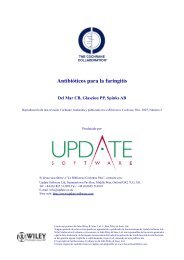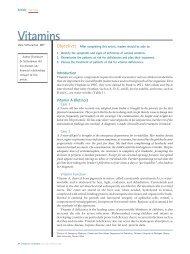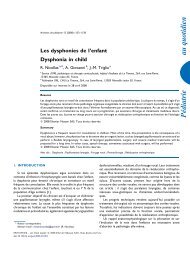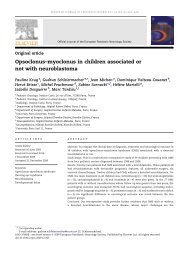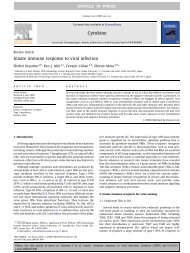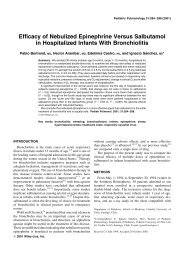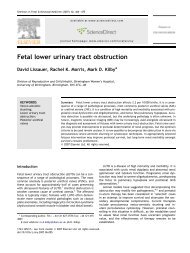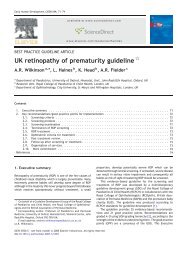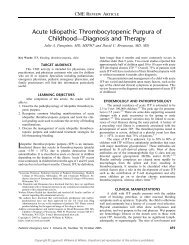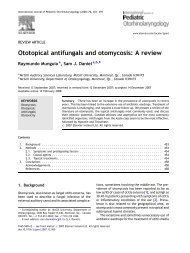Severe hypertension in children and adolescents ... - ResearchGate
Severe hypertension in children and adolescents ... - ResearchGate
Severe hypertension in children and adolescents ... - ResearchGate
Create successful ePaper yourself
Turn your PDF publications into a flip-book with our unique Google optimized e-Paper software.
Pediatr Nephrol (2009) 24:1101–1112<br />
DOI 10.1007/s00467-008-1000-1<br />
REVIEW<br />
<strong>Severe</strong> <strong>hypertension</strong> <strong>in</strong> <strong>children</strong> <strong>and</strong> <strong>adolescents</strong>:<br />
pathophysiology <strong>and</strong> treatment<br />
Joseph T. Flynn & Kjell Tullus<br />
Received: 24 June 2008 /Revised: 18 August 2008 /Accepted: 19 August 2008 / Published onl<strong>in</strong>e: 7 October 2008<br />
# IPNA 2008<br />
Abstract <strong>Severe</strong>, symptomatic <strong>hypertension</strong> occurs uncommonly<br />
<strong>in</strong> <strong>children</strong>, usually only <strong>in</strong> those with underly<strong>in</strong>g<br />
congenital or acquired renal disease. If such<br />
<strong>hypertension</strong> has been long-st<strong>and</strong><strong>in</strong>g, then rapid blood<br />
pressure reduction may be risky due to altered cerebral<br />
hemodynamics. While many drugs are available for the<br />
treatment of severe <strong>hypertension</strong> <strong>in</strong> adults, few have been<br />
studied <strong>in</strong> <strong>children</strong>. Despite the lack of scientific studies,<br />
some agents, particularly cont<strong>in</strong>uous <strong>in</strong>travenous <strong>in</strong>fusions<br />
of nicardip<strong>in</strong>e <strong>and</strong> labetalol, are preferred <strong>in</strong> many centers.<br />
These agents generally provide the ability to control the<br />
magnitude <strong>and</strong> rapidity of blood pressure reduction <strong>and</strong><br />
should—<strong>in</strong> conjunction with careful patient monitor<strong>in</strong>g—<br />
allow the safe reduction of blood pressure <strong>and</strong> the<br />
avoidance of complications. This review provides a<br />
summary of the underly<strong>in</strong>g causes <strong>and</strong> pathophysiology of<br />
acute severe <strong>hypertension</strong> <strong>in</strong> childhood as well as a detailed<br />
discussion of drug treatment <strong>and</strong> the optimal cl<strong>in</strong>ical<br />
approach to manag<strong>in</strong>g <strong>children</strong> <strong>and</strong> <strong>adolescents</strong> with acute<br />
severe <strong>hypertension</strong>.<br />
J. T. Flynn<br />
Pediatric Hypertension Program, Department of Pediatrics,<br />
University of Wash<strong>in</strong>gton School of Medic<strong>in</strong>e,<br />
Seattle, WA, USA<br />
J. T. Flynn (*)<br />
Division of Nephrology, A-7931,<br />
Children’s Hospital & Regional Medical Center,<br />
4800 S<strong>and</strong> Po<strong>in</strong>t Way NE,<br />
Seattle, WA 98105, USA<br />
e-mail: joseph.flynn@seattle<strong>children</strong>s.org<br />
K. Tullus<br />
Great Ormond Street Hospital for Children,<br />
Great Ormond Street,<br />
London WC1N 3JH, UK<br />
Keywords Children . Clonid<strong>in</strong>e . Esmolol . Hydralaz<strong>in</strong>e .<br />
Hypertension . Kidney disease . Labetalol . Nicardip<strong>in</strong>e<br />
Introduction<br />
Hypertension <strong>in</strong> <strong>children</strong> <strong>and</strong> <strong>adolescents</strong> is def<strong>in</strong>ed as a<br />
susta<strong>in</strong>ed systolic (S) <strong>and</strong>/or diastolic blood pressure (DBP)<br />
elevation greater than or equal to the 95th percentile for<br />
age, gender, <strong>and</strong> height [1]. Its severity can be further<br />
classified accord<strong>in</strong>g to the scheme <strong>in</strong> Table 1.<br />
<strong>Severe</strong> <strong>hypertension</strong>, however, has not been as rigorously<br />
def<strong>in</strong>ed, which has led to some confusion with respect to<br />
term<strong>in</strong>ology. For the purposes of this review, severe<br />
<strong>hypertension</strong> is def<strong>in</strong>ed as a BP elevation that fulfills (<strong>and</strong><br />
usually exceeds) the def<strong>in</strong>ition of stage 2 <strong>hypertension</strong> <strong>and</strong><br />
that is accompanied by severe symptoms; physical exam<br />
<strong>and</strong>/or laboratory f<strong>in</strong>d<strong>in</strong>gs of accelerated <strong>hypertension</strong> are<br />
frequently also present.<br />
<strong>Severe</strong> <strong>hypertension</strong> has traditionally been divided <strong>in</strong>to<br />
hypertensive emergencies <strong>and</strong> hypertensive urgencies; the<br />
former is associated with life-threaten<strong>in</strong>g symptoms <strong>and</strong>/or<br />
target-organ <strong>in</strong>jury, <strong>and</strong> the latter is associated with less<br />
significant symptoms <strong>and</strong> no target-organ <strong>in</strong>jury [2]. For<br />
example, an adolescent with seizures <strong>and</strong> hypertensive<br />
encephalopathy would be considered as experienc<strong>in</strong>g a<br />
hypertensive emergency, whereas a hypertensive child with<br />
nausea <strong>and</strong> vomit<strong>in</strong>g would be classified as a hypertensive<br />
urgency. This dist<strong>in</strong>ction is not absolute <strong>and</strong> depends<br />
somewhat on cl<strong>in</strong>ical judgment.<br />
Peri-operative <strong>hypertension</strong> is commonly also classified<br />
as a hypertensive urgency <strong>in</strong> order to emphasize the need<br />
for prompt therapy to prevent complications [3]. Perhaps<br />
the most significant aspect of any hypertensive urgency is
1102 Pediatr Nephrol (2009) 24:1101–1112<br />
Table 1 Classification of normal <strong>and</strong> abnormal blood pressure <strong>in</strong> <strong>children</strong> <strong>and</strong> <strong>adolescents</strong> a<br />
Classification of blood pressure<br />
Normal<br />
Pre<strong>hypertension</strong><br />
Stage 1 <strong>hypertension</strong><br />
Stage 2 <strong>hypertension</strong><br />
SBP or DBP<br />
Pediatr Nephrol (2009) 24:1101–1112 1103<br />
Cl<strong>in</strong>ical presentation<br />
Children with severe <strong>hypertension</strong> can present <strong>in</strong> many<br />
different ways (Table 3). Some present with very severe<br />
symptoms from heart failure or a cerebral <strong>in</strong>sult, while<br />
others are totally asymptomatic. The urgency to br<strong>in</strong>g down<br />
the BP will obviously also be <strong>in</strong>fluenced by the mode of<br />
presentation. For example, we have seen a number of<br />
<strong>children</strong> present<strong>in</strong>g with a systolic BP of 200 mmHg or<br />
more which has been documented for many months <strong>and</strong><br />
occasionally several years that are still totally asymptomatic<br />
when they come to us. These <strong>children</strong> clearly need their BP<br />
lowered, but the urgency to do so is not as great as <strong>in</strong><br />
symptomatic <strong>children</strong>.<br />
Children present<strong>in</strong>g with severe symptoms need to be<br />
treated much more rapidly. However, it may be risky to<br />
lower the BP too rapidly, especially <strong>in</strong> those whose<br />
<strong>hypertension</strong> has been long-st<strong>and</strong><strong>in</strong>g. In such patients, a<br />
shift <strong>in</strong> cerebral autoregulation occurs (Fig. 1), which <strong>in</strong> the<br />
hypertensive state protects the bra<strong>in</strong> from excessive<br />
perfusion [8]. A too rapid lower<strong>in</strong>g of the BP <strong>in</strong> patients<br />
with such alterations of cerebral flow might lead to<br />
ischemic stroke from underperfusion of the bra<strong>in</strong>. Unfortunately,<br />
little data are available to guide practitioners on the<br />
safest rate of BP reduction <strong>in</strong> such patients. Based upon our<br />
comb<strong>in</strong>ed cl<strong>in</strong>ical experience <strong>and</strong> synthesis of available<br />
data <strong>in</strong> adults, we normally recommend that the BP should<br />
be reduced by 25% of the planned BP reduction over first<br />
8–12 h, a further 25% over the next 8–12 h, <strong>and</strong> the f<strong>in</strong>al<br />
50% over the 24 h after that.<br />
Physical exam f<strong>in</strong>d<strong>in</strong>gs of accelerated <strong>hypertension</strong> (for<br />
example, papilledema, congestive heart failure, pulmonary<br />
edema) are usually only seen <strong>in</strong> hypertensive emergencies.<br />
Additionally, many <strong>children</strong> with severe <strong>hypertension</strong> will<br />
at presentation have signs of hypertensive end-organ<br />
damage. In a group of 33 <strong>children</strong> with severe <strong>hypertension</strong><br />
need<strong>in</strong>g angioplasty, we found evidence of left ventricular<br />
hypertrophy <strong>in</strong> 22 <strong>children</strong> (66%), with three (9%) patients<br />
<strong>in</strong> congestive cardiac failure [9]. Hypertensive ret<strong>in</strong>opathy<br />
was present <strong>in</strong> ten (33%) <strong>children</strong> at presentation.<br />
Hypertensive encephalopathy is a very severe complication<br />
seen <strong>in</strong> some <strong>children</strong> with severe <strong>hypertension</strong>. This<br />
condition is caused by a failure of the upper limit of the<br />
autoregulation of cerebral blood flow (Fig. 1), which leads<br />
to cerebral hypoperfusion. Seizures can be present<strong>in</strong>g<br />
symptoms <strong>and</strong> also lethargy, confusion, headache, <strong>and</strong><br />
visual disturbances, <strong>in</strong>clud<strong>in</strong>g bl<strong>in</strong>dness [10]. Magnetic<br />
resonance imag<strong>in</strong>g will demonstrate characteristic f<strong>in</strong>d<strong>in</strong>gs<br />
of posterior leucoencephalopathy predom<strong>in</strong>antly affect<strong>in</strong>g<br />
the parieto-occipital white matter [11]. These f<strong>in</strong>d<strong>in</strong>gs are<br />
potentially totally reversible after correction of the<br />
<strong>hypertension</strong>.<br />
Pathophysiology<br />
Blood pressure is a function of cardiac output <strong>and</strong><br />
peripheral resistance. Several different pathophysiologic<br />
mechanisms can lead to severe <strong>hypertension</strong>. Increased<br />
cardiac output can be caused by <strong>in</strong>creased stroke volume<br />
<strong>and</strong> <strong>in</strong>creased heart rate. The stroke volume is, among other<br />
th<strong>in</strong>gs, <strong>in</strong>fluenced by the extracellular fluid volume. We<br />
will discuss these <strong>in</strong> this section <strong>and</strong> also emphasize<br />
mechanisms that are most important <strong>in</strong> the development<br />
of severe <strong>hypertension</strong>.<br />
Ren<strong>in</strong>–angiotens<strong>in</strong> system<br />
Ren<strong>in</strong> is secreted from the juxtaglomerular apparatus <strong>in</strong> the<br />
kidneys. It cleaves angiotens<strong>in</strong>ogen to the deca-peptide<br />
angiotens<strong>in</strong> I. Angiotens<strong>in</strong>-convert<strong>in</strong>g enzyme (ACE) then<br />
converts angiotens<strong>in</strong> I further to the active component<br />
angiotens<strong>in</strong> II (AII), which can cause <strong>hypertension</strong> through<br />
several mechanisms [12]. Angiotens<strong>in</strong> II is a potent<br />
vasoconstrictor agent through its b<strong>in</strong>d<strong>in</strong>g to the angiotens<strong>in</strong><br />
II receptor I (AT 1). This b<strong>in</strong>d<strong>in</strong>g also promotes several<br />
other processes that cause <strong>hypertension</strong>, <strong>in</strong>clud<strong>in</strong>g <strong>in</strong>clude<br />
sodium retention, vascular cell hypertrophy, <strong>and</strong> the<br />
<strong>in</strong>duction of several pro<strong>in</strong>flammatory <strong>and</strong> profibrotic pathways.<br />
Polymorphisms of this receptor seem to be related to<br />
Table 3 Present<strong>in</strong>g features <strong>in</strong> <strong>children</strong> with severe <strong>hypertension</strong><br />
(modified from [7])<br />
Mode of presentation<br />
Number<br />
Incidental 9<br />
Cardiac (congestive cardiac failure, palpitations, murmur) 7<br />
Headache ± vomit<strong>in</strong>g ± lethargy 6<br />
Acute hypertensive encephalopathy 3<br />
Cerebrovascular accident 2<br />
Facial palsy 2<br />
Poor feed<strong>in</strong>g <strong>and</strong> failure to thrive 2<br />
Other 2<br />
Fig. 1 Altered cerebral autoregulation <strong>in</strong> chronic <strong>hypertension</strong>
1104 Pediatr Nephrol (2009) 24:1101–1112<br />
an <strong>in</strong>creased risk, at least <strong>in</strong> adult patients, to develop<br />
<strong>hypertension</strong>.<br />
Angiotens<strong>in</strong> II also b<strong>in</strong>ds to another receptor, AT 2. This<br />
b<strong>in</strong>d<strong>in</strong>g produces effects that counteract those of AT 1, such<br />
as vasodilation <strong>and</strong> natriuresis, among others, <strong>and</strong> this<br />
b<strong>in</strong>d<strong>in</strong>g thus reduces the BP. Angiotens<strong>in</strong> II also <strong>in</strong>duces<br />
the synthesis of aldosterone <strong>in</strong> the zona glomerulosa of the<br />
adrenals, <strong>in</strong> various parts of the vascular tree (endothelial<br />
cells <strong>and</strong> vascular smooth muscle cells), <strong>and</strong> <strong>in</strong> parts of the<br />
bra<strong>in</strong>. Aldosterone <strong>in</strong>duces sodium retention <strong>and</strong> potassium<br />
excretion <strong>and</strong> thus <strong>in</strong>creases the circulat<strong>in</strong>g blood volume.<br />
The sympathetic nervous system can be activated by<br />
aldosterone. There is also evidence that AII has toxic<br />
effects on the vessel wall via its pro<strong>in</strong>flammatory action<br />
[13].<br />
High ren<strong>in</strong> <strong>and</strong> high aldosterone levels have been found<br />
to be the cause of <strong>hypertension</strong> <strong>in</strong> many kidney diseases,<br />
but they are of particular importance <strong>in</strong> renovascular<br />
<strong>hypertension</strong>. The underly<strong>in</strong>g mechanism of the <strong>in</strong>creased<br />
secretion is often glomerular underperfusion, but reduced<br />
sodium load or stimulation from the sympathetic nervous<br />
system may also play a role.<br />
Ren<strong>in</strong> seems to be of particular importance <strong>in</strong> the<br />
development of severe <strong>hypertension</strong> <strong>and</strong> the endothelial<br />
dysfunction seen <strong>in</strong> such cases, as evidenced <strong>in</strong> animal<br />
models. Rats that express the mouse ren<strong>in</strong> gene Ren-2,<br />
rapidly develop malignant <strong>hypertension</strong> compared to rats<br />
from the same background population [14]. When such rats<br />
were treated with an ACE <strong>in</strong>hibitor (I), only 4% developed<br />
severe <strong>hypertension</strong> compared to 63% of the non-treated<br />
controls [15]. Significantly less evidence of tissue <strong>in</strong>jury,<br />
such as <strong>in</strong>timal fibrosis, fibr<strong>in</strong>oid necrosis, <strong>and</strong> nephron<br />
damage, was observed <strong>in</strong> the ACEi-treated group, <strong>and</strong> the<br />
mortality among these treated rats was reduced to 4%<br />
compared to 25% <strong>in</strong> the non-treated controls.<br />
Fluid overload<br />
Fluid overload is the most common mechanism lead<strong>in</strong>g to<br />
<strong>hypertension</strong> <strong>in</strong> <strong>children</strong> with renal diseases. It is often<br />
caused by acute renal failure with oliguria or anuria. Ren<strong>in</strong>dependent<br />
<strong>in</strong>creased production of aldosterone <strong>and</strong> AIIstimulated<br />
sodium retention are also very important<br />
contributors to the fluid overload. Increased vasopress<strong>in</strong><br />
levels can sometimes be found <strong>in</strong> patients with severe<br />
<strong>hypertension</strong> <strong>and</strong> may <strong>in</strong>deed aggravate the <strong>hypertension</strong><br />
[16].<br />
In <strong>children</strong> on dialysis, fluid overload is probably the<br />
most important contribut<strong>in</strong>g factor to episodes of severe<br />
<strong>hypertension</strong>. Fluid overload <strong>in</strong> dialysis patients often<br />
results from poor adherence to dietary sodium <strong>and</strong> fluid<br />
restrictions. Chronic under-dialysis <strong>and</strong> failure to consistently<br />
reach “dry weight” may lead to gradual fluid<br />
accumulation that can be cl<strong>in</strong>ically imperceptible until the<br />
child presents with a hypertensive crisis. This may happen<br />
even <strong>in</strong> the best dialysis center due to the difficulty <strong>in</strong><br />
assess<strong>in</strong>g the fluid status <strong>in</strong> <strong>children</strong> <strong>and</strong> also because<br />
differences <strong>in</strong> body weight may be attributed to growth<br />
<strong>in</strong>stead of to fluid accumulation.<br />
Sympathetic stimulation<br />
The sympathetic nervous system can be the ma<strong>in</strong> cause of<br />
severe <strong>hypertension</strong>. This is particularly seen <strong>in</strong> <strong>children</strong><br />
with pheochromocytomas <strong>and</strong> other tumors that produce<br />
vasoactive substances, <strong>in</strong>clud<strong>in</strong>g neuroblastoma [17]. Hemodialysis<br />
can contribute to a substantial <strong>in</strong>crease <strong>in</strong><br />
catecholam<strong>in</strong>es <strong>and</strong> also of ren<strong>in</strong>, which <strong>in</strong> turn can<br />
contribute to <strong>hypertension</strong> [18]. Increased sympathetic<br />
activity can worsen severe <strong>hypertension</strong> <strong>in</strong> several conditions,<br />
<strong>in</strong>clud<strong>in</strong>g renovascular <strong>hypertension</strong> <strong>and</strong> polycystic<br />
kidney disease, <strong>and</strong> seems to be unrelated to kidney<br />
function. Renal ischaemia triggered by these diseases seems<br />
to cause the systemic over-activation [19]. Activation of the<br />
sympathetic nervous system lead<strong>in</strong>g to systemic vasoconstriction<br />
is generally accepted as the mechanism of severe<br />
post-operative <strong>hypertension</strong> [3].<br />
Other vasoactive systems may also be important <strong>in</strong> the<br />
development of severe <strong>hypertension</strong>. Conflict<strong>in</strong>g data are<br />
found regard<strong>in</strong>g the importance of endothel<strong>in</strong> [20]. Reduced<br />
levels of nitric oxide have been reported to contribute<br />
to the <strong>hypertension</strong>, especially <strong>in</strong> the presence of renal<br />
impairment [21].<br />
Endothelial dysfunction<br />
The endothelium seems to play a crucial role <strong>in</strong> the<br />
development of severe symptomatic <strong>hypertension</strong>. Angiotens<strong>in</strong><br />
II has many effects on the blood vessel wall that<br />
result <strong>in</strong> endothelial dysfunction with a shift of endothelial<br />
action toward reduced vasodilatation, a pro<strong>in</strong>flammatory<br />
state, <strong>and</strong> prothrombotic properties [22]. The mechanisms<br />
that participate <strong>in</strong> the reduced vasodilatory response<br />
<strong>in</strong>clude reduced nitric oxide generation <strong>and</strong> an oxidative<br />
excess. The compensatory vasodilatation that occurs <strong>in</strong><br />
response to the raised blood pressure becomes overwhelmed,<br />
which leads to decompensation of the endothelium<br />
<strong>and</strong> a further rise of the blood pressure—<strong>and</strong> a vicious<br />
circle develops.<br />
It has been shown <strong>in</strong> rats that AII mediates many of its<br />
different actions over several transcription factors, most<br />
notably NF-κB. This transcription factor promotes the<br />
production of a large number of pro<strong>in</strong>flammatory molecules,<br />
<strong>in</strong>clud<strong>in</strong>g pro<strong>in</strong>flammatory cytok<strong>in</strong>es such as several<br />
<strong>in</strong>terleuk<strong>in</strong>s <strong>and</strong> tumor necrosis factor-α, chemok<strong>in</strong>es such<br />
as MCP1, <strong>and</strong> vascular adhesion molecules. These all act <strong>in</strong>
Pediatr Nephrol (2009) 24:1101–1112 1105<br />
concert promot<strong>in</strong>g <strong>in</strong>flammation of the blood vessel wall<br />
[23]. Double transgenic rats with both the ren<strong>in</strong> <strong>and</strong><br />
angiotens<strong>in</strong> genes have <strong>in</strong>creased activation of NF-κB <strong>and</strong><br />
marked renal <strong>and</strong> cardiac end-organ damage. When they<br />
were treated with a substance that <strong>in</strong>hibits NF-κB, their<br />
blood pressure decreased significantly <strong>and</strong> so did their<br />
cardiac hypertrophy <strong>in</strong>dex <strong>and</strong> 24-h prote<strong>in</strong>uria [24]. A<br />
40% 7-week mortality <strong>in</strong> the untreated rats was also<br />
prevented. Signs of an <strong>in</strong>flammatory response were also<br />
attenuated; monocyte <strong>and</strong> macrophage <strong>in</strong>filtration <strong>in</strong><br />
kidneys <strong>and</strong> the heart was also reduced by 72 <strong>and</strong> 64%,<br />
respectively. F<strong>in</strong>d<strong>in</strong>gs <strong>in</strong> adult patients with malignant<br />
<strong>hypertension</strong> also reveal endothelial activation; these<br />
patients exhibit higher serum levels of both soluble P-<br />
select<strong>in</strong> <strong>and</strong> von Willebr<strong>and</strong> factor [25].<br />
Medications <strong>and</strong> other substances<br />
There are numerous medications <strong>and</strong> other substances that<br />
can acutely elevate blood pressure by a variety of<br />
mechanisms. Although relatively uncommon <strong>in</strong> the pediatric<br />
age group, the <strong>in</strong>gestion of recreational drugs, such as<br />
coca<strong>in</strong>e, amphetam<strong>in</strong>e, or phencyclid<strong>in</strong>e, can produce<br />
severe acute <strong>hypertension</strong> via sympathetic overstimulation<br />
[2]. Immunosuppressive medications used <strong>in</strong> solid organ<br />
transplantation, specifically corticosteroids <strong>and</strong> calc<strong>in</strong>eur<strong>in</strong><br />
<strong>in</strong>hibitors, may also result <strong>in</strong> relatively severe<br />
<strong>hypertension</strong> requir<strong>in</strong>g prompt <strong>in</strong>tervention [10]. Fluid<br />
overload, activation of the ren<strong>in</strong>–angiotens<strong>in</strong> system, <strong>and</strong><br />
afferent glomerular arteriolar vasoconstriction are among<br />
the medication-related mechanisms at play <strong>in</strong> such patients<br />
[26]. For a more complete discussion, the <strong>in</strong>terested reader<br />
is referred to recent reviews on this topic [27].<br />
Drugs used to treat severe <strong>hypertension</strong><br />
Availability of drugs with established efficacy <strong>in</strong> <strong>children</strong><br />
Therapeutic options for pediatric patients requir<strong>in</strong>g treatment<br />
for severe <strong>hypertension</strong> are significantly limited: only<br />
half of the <strong>in</strong>travenous antihypertensive medications currently<br />
marketed <strong>in</strong> the USA have pediatric label<strong>in</strong>g<br />
approved by the Food <strong>and</strong> Drug Adm<strong>in</strong>istration (FDA)<br />
(Table 4). Of those agents with approved pediatric label<strong>in</strong>g,<br />
one is no longer <strong>in</strong> rout<strong>in</strong>e use (diazoxide), <strong>and</strong> another was<br />
demonstrated to have limited efficacy <strong>in</strong> <strong>children</strong> compared<br />
to adults (fenoldopam) [28]. Because of this, practitioners<br />
who care for <strong>children</strong> with severe <strong>hypertension</strong> have had to<br />
use unapproved medications on an off-label basis. The<br />
many recent reports of pediatric use of nicardip<strong>in</strong>e [4, 29–<br />
32] are a salient example of this phenomenon. Another<br />
example is the widespread use of medications that no<br />
longer have patent protection <strong>and</strong> are unlikely to ever get<br />
pediatric label<strong>in</strong>g [33].<br />
Recent government <strong>in</strong>itiatives <strong>in</strong> both the USA <strong>and</strong><br />
Europe offer the hope of improv<strong>in</strong>g this situation. Both the<br />
FDA <strong>in</strong> the USA <strong>and</strong> the European Medic<strong>in</strong>es Agency now<br />
provide <strong>in</strong>centives to manufacturers to conduct cl<strong>in</strong>ical<br />
trials of medications <strong>in</strong> <strong>children</strong>; this may result <strong>in</strong> new<br />
pediatric label<strong>in</strong>g for the medications studied [33, 34].<br />
Additionally, <strong>in</strong> the USA, the Best Pharmaceuticals for<br />
Children Act [35] also provides a mechanism for study<strong>in</strong>g<br />
medications <strong>in</strong> <strong>children</strong> that no longer have patent<br />
protection. With respect to medications for severe <strong>hypertension</strong>,<br />
there is now ongo<strong>in</strong>g a study of <strong>in</strong>travenous<br />
nitroprusside [Cl<strong>in</strong>icalTrials.gov Identifier: NCT00135668]<br />
that should provide important data regard<strong>in</strong>g the efficacy<br />
<strong>and</strong> safety of this agent <strong>in</strong> <strong>children</strong>.<br />
Intravenous agents currently used <strong>in</strong> <strong>children</strong> with severe<br />
<strong>hypertension</strong><br />
A variety of <strong>in</strong>travenous antihypertensive agents are currently<br />
<strong>in</strong> widespread use for emergency reduction of acute<br />
<strong>hypertension</strong> <strong>in</strong> <strong>children</strong>, <strong>in</strong>clud<strong>in</strong>g sodium nitroprusside,<br />
labetalol, nicardip<strong>in</strong>e, hydralaz<strong>in</strong>e, diazoxide, <strong>and</strong> esmolol.<br />
Enalaprilat, the <strong>in</strong>travenous formulation of the ACE <strong>in</strong>hibitor<br />
enalapril, has been utilized to a more limited degree <strong>in</strong> this<br />
sett<strong>in</strong>g as well. Each of these agents has unique properties<br />
<strong>and</strong> adverse effects that practitioners should be aware of.<br />
Sodium nitroprusside is a direct vasodilator of both<br />
arteriolar <strong>and</strong> venous smooth muscle cells. It is metabolized<br />
to nitric oxide, which dilates both arterioles <strong>and</strong> venules,<br />
result<strong>in</strong>g <strong>in</strong> both a reduced total peripheral resistance <strong>and</strong><br />
reduced venous return, thus decreas<strong>in</strong>g both preload <strong>and</strong><br />
afterload. For this reason, this agent can be used <strong>in</strong> severe<br />
congestive heart failure as well as <strong>in</strong> patients with severe<br />
<strong>hypertension</strong> [36]. Nitroprusside has a rapid onset of action,<br />
1–2 m<strong>in</strong>, <strong>and</strong> a plasma half-life of
1106 Pediatr Nephrol (2009) 24:1101–1112<br />
Table 4 Pediatric label<strong>in</strong>g status of <strong>in</strong>travenous antihypertensives<br />
Agent<br />
FDA-approved<br />
pediatric label?<br />
Label <strong>in</strong>formation on pediatric use<br />
Reference<br />
Diazoxide a Yes “HYPERSTAT IV Injection is <strong>in</strong>dicated for short-term use <strong>in</strong> the<br />
emergency reduction of blood pressure…<strong>in</strong> acute severe <strong>hypertension</strong><br />
<strong>in</strong> hospitalized <strong>children</strong>, when prompt <strong>and</strong> urgent decrease of diastolic<br />
blood pressure is required.”<br />
Package <strong>in</strong>sert (Scher<strong>in</strong>g Corp.,<br />
Kenilworth, NJ)<br />
Enalaprilat No “Safety <strong>and</strong> effectiveness <strong>in</strong> <strong>children</strong> have not been established.” Package <strong>in</strong>sert (Merck & Co.,<br />
West Po<strong>in</strong>t, PA)<br />
Esmolol b No “The safety <strong>and</strong> effectiveness of BREVIBLOC (Esmolol Hydrochloride)<br />
<strong>in</strong> pediatric patients have not been established.”<br />
Package <strong>in</strong>sert (Baxter<br />
Heathcare Corp., New<br />
Providence, NJ)<br />
Fenoldopam c Yes “Fenoldopam is <strong>in</strong>dicated for the <strong>in</strong>-hospital, short-term (up to 4 hours)<br />
reduction <strong>in</strong> blood pressure.”<br />
Hydralaz<strong>in</strong>e Yes “Safety <strong>and</strong> effectiveness <strong>in</strong> pediatric patients have not been established<br />
<strong>in</strong> controlled cl<strong>in</strong>ical trials, although there is experience with the use<br />
of hydralaz<strong>in</strong>e hydrochloride <strong>in</strong> <strong>children</strong>. The usual recommended<br />
parenteral dosage, adm<strong>in</strong>istered <strong>in</strong>tramuscularly or <strong>in</strong>travenously, is<br />
1.7–3.5 mg/kg of body weight daily, divided <strong>in</strong>to four to six doses.”<br />
Package <strong>in</strong>sert (Abbott<br />
Laboratories, North Chicago,<br />
IL)<br />
Package <strong>in</strong>sert (American<br />
Regent, Inc., Shirley, NY)<br />
Labetalol No “Safety <strong>and</strong> effectiveness <strong>in</strong> <strong>children</strong> have not been established.” Package <strong>in</strong>sert (Bedford<br />
Laboratories, Bedford, OH)<br />
Nicardip<strong>in</strong>e No “Safety <strong>and</strong> efficacy <strong>in</strong> patients under the age of 18 have not been<br />
established.”<br />
Package <strong>in</strong>sert (PDL<br />
BioPharma, Redwood City,<br />
CA)<br />
Sodium<br />
nitroprusside d Yes Conta<strong>in</strong>s weight-based dos<strong>in</strong>g recommendations for patients ≥10 kg Package <strong>in</strong>sert (Hospira, Inc.,<br />
Lake Forest, IL)<br />
FDA, Food <strong>and</strong> Drug Adm<strong>in</strong>istration<br />
a No longer recommended for use <strong>in</strong> <strong>children</strong> [1]<br />
b Pediatric trial completed but no pediatric label<strong>in</strong>g has been approved by FDA<br />
c Pediatric trial demonstrated relatively poor efficacy <strong>in</strong> <strong>children</strong> compared to adults [20]<br />
d Pediatric trial currently underway<br />
vasodilatation; hemodynamic studies have demonstrated that<br />
labetalol lowers peripheral resistance with little or no effect<br />
on cardiac output. Adm<strong>in</strong>istered <strong>in</strong>travenously, it is this<br />
vasodilatation which accounts for labetalol’s efficacy<strong>in</strong>the<br />
treatment of severe <strong>hypertension</strong>. The hypotensive effects of<br />
a s<strong>in</strong>gle dose of <strong>in</strong>travenous labetalol appear with<strong>in</strong> 2–5 m<strong>in</strong><br />
after adm<strong>in</strong>istration, peak at 5–15 m<strong>in</strong>, <strong>and</strong> last up to 2–4 h.<br />
Intravenously adm<strong>in</strong>istered labetalol has been extensively<br />
studied <strong>in</strong> adults with severe <strong>hypertension</strong> [37], <strong>and</strong> case<br />
series of successful use <strong>in</strong> <strong>children</strong> with severe <strong>hypertension</strong><br />
have been published [5, 38]. Adverse reactions are those<br />
expected from a beta-adrenergic blocker, <strong>in</strong>clud<strong>in</strong>g bradycardia<br />
<strong>and</strong> bronchospasm. It is contra<strong>in</strong>dicated <strong>in</strong> patients<br />
with acute left ventricular failure. Intravenous labetalol can<br />
be adm<strong>in</strong>istered as a cont<strong>in</strong>uous <strong>in</strong>fusion or by bolus<br />
<strong>in</strong>jection; repeated dos<strong>in</strong>g of small doses has also been<br />
described <strong>in</strong> adults <strong>and</strong> may be appropriate <strong>in</strong> selected<br />
cl<strong>in</strong>ical sett<strong>in</strong>gs, such as the Emergency Department [37].<br />
Conversion to oral dos<strong>in</strong>g is relatively straight-forward, but<br />
the cl<strong>in</strong>ician should be aware that the alpha-to-beta block<strong>in</strong>g<br />
ratio of the oral preparation is 1:3, whereas it is 1:7 for the<br />
<strong>in</strong>travenous preparation.<br />
Nicardip<strong>in</strong>e is a second-generation dihydropyrid<strong>in</strong>e<br />
calcium channel blocker that has been shown to be an<br />
effective antihypertensive agent <strong>in</strong> numerous studies <strong>in</strong><br />
adults, compar<strong>in</strong>g favorably to nitroprusside <strong>in</strong> terms of<br />
overall efficacy [39]. It has high vascular selectivity <strong>and</strong><br />
strong cerebral <strong>and</strong> coronary vasodilatory activity; the latter<br />
property probably accounts for its favorable effects on<br />
myocardial oxygen balance. The <strong>in</strong>itial onset of nicardip<strong>in</strong>e<br />
given <strong>in</strong>travenously occurs with<strong>in</strong> 1 m<strong>in</strong>, <strong>and</strong> the duration<br />
of action after a s<strong>in</strong>gle <strong>in</strong>travenous dose is approximately<br />
3 h. Upon term<strong>in</strong>ation of <strong>in</strong>fusions of nicardip<strong>in</strong>e, plasma<br />
concentrations rapidly decl<strong>in</strong>e, with at least a 50% decrease<br />
dur<strong>in</strong>g the first 2 h.<br />
Many pediatric case series of <strong>in</strong>travenous nicardip<strong>in</strong>e use<br />
have been published [6, 29–32]; <strong>in</strong> all of these, it has been<br />
reported to be effective <strong>and</strong> well-tolerated. A multicenter trial<br />
of <strong>in</strong>travenous nicardip<strong>in</strong>e <strong>in</strong> hypertensive <strong>children</strong> that had<br />
been <strong>in</strong>itiated (Cl<strong>in</strong>icalTrials.gov Identifier: NCT00528827)<br />
was unfortunately recently term<strong>in</strong>ated due to the sale of the<br />
drug by the sponsor of the trial. Common adverse reactions<br />
<strong>in</strong>clude phlebitis at the site of adm<strong>in</strong>istration <strong>and</strong> tachycardia<br />
which usually is not cl<strong>in</strong>ically significant. The conversion of
Pediatr Nephrol (2009) 24:1101–1112 1107<br />
nicardip<strong>in</strong>e <strong>in</strong>fusions to oral dos<strong>in</strong>g has been reported <strong>in</strong><br />
adults [40], but no such data exist for <strong>children</strong>.<br />
Hydralaz<strong>in</strong>e is a direct vasodilator of arteriolar smooth<br />
muscle with an unclear mechanism of action, most likely an<br />
alteration of <strong>in</strong>tracellular calcium metabolism, lead<strong>in</strong>g to<br />
<strong>in</strong>terference with the calcium movements with<strong>in</strong> the vascular<br />
smooth muscle that are responsible for <strong>in</strong>itiat<strong>in</strong>g or ma<strong>in</strong>ta<strong>in</strong><strong>in</strong>g<br />
the contractile state. It does not affect coronary<br />
arteries or venous smooth muscle, but its effects on arteriolar<br />
smooth muscle stimulates the sympathetic nervous system,<br />
lead<strong>in</strong>g to tachycardia, <strong>in</strong>creased ren<strong>in</strong> activity, <strong>and</strong> sodium<br />
retention [41]. The average maximal decrease <strong>in</strong> blood<br />
pressure usually occurs 10–80 m<strong>in</strong> after <strong>in</strong>travenous adm<strong>in</strong>istration.<br />
An advantage of hydralaz<strong>in</strong>e compared to other<br />
agents discussed here<strong>in</strong> is that it can be adm<strong>in</strong>istered<br />
<strong>in</strong>tramuscularly, which can be useful <strong>in</strong> situations when<br />
there is an immediate need to lower blood pressure but the<br />
patient does not yet have <strong>in</strong>travenous access established.<br />
Patients treated with <strong>in</strong>travenous hydralaz<strong>in</strong>e can be easily<br />
converted to oral dos<strong>in</strong>g; additionally, oral hydralaz<strong>in</strong>e may<br />
be useful <strong>in</strong> patients with less severe <strong>hypertension</strong> who are<br />
able to tolerate oral drugs. When adm<strong>in</strong>istered orally,<br />
hydralaz<strong>in</strong>e has an onset of action of 30 m<strong>in</strong> to 2 h <strong>and</strong> an<br />
unpredictable duration of action of 6–12 h. However,<br />
prolonged treatment with hydralaz<strong>in</strong>e may be difficult to<br />
ma<strong>in</strong>ta<strong>in</strong> <strong>in</strong> young <strong>children</strong> given the limited stability of<br />
extemporaneous suspensions of hydralaz<strong>in</strong>e [42].<br />
Diazoxide is another direct vasodilator that acts by<br />
<strong>in</strong>creas<strong>in</strong>g the permeability of the vascular smooth muscle<br />
cell membrane to potassium ions. This <strong>in</strong>creased permeability<br />
switches off voltage-gated calcium ion channels,<br />
which <strong>in</strong> turn <strong>in</strong>hibits the generation of an action potential<br />
[43]. Diazoxide has a long history of use for the treatment<br />
of hypertensive emergencies <strong>in</strong> adults <strong>and</strong> has been utilized<br />
<strong>in</strong> <strong>children</strong> with severe <strong>hypertension</strong> for many years as<br />
well. In a multicenter study of 36 <strong>children</strong> with severe<br />
symptomatic <strong>hypertension</strong> (BP >100 mmHg) of various<br />
causes, mostly parenchymal renal disease, McCrory <strong>and</strong><br />
colleagues demonstrated that <strong>in</strong>travenous diazoxide<br />
promptly reduced systolic <strong>and</strong> diastolic BP without significant<br />
adverse effects [44]. Reductions of about 23–27% for<br />
SBP <strong>and</strong> 32–42% for DBP were achieved with <strong>in</strong>itial<br />
dos<strong>in</strong>g; the BP subsequently rose slightly, but BP reduction<br />
was susta<strong>in</strong>ed for about 6 hours. Diazoxide was successful<br />
<strong>in</strong> 94% of the patients, <strong>in</strong>clud<strong>in</strong>g those who had failed prior<br />
treatment with other agents. Diazoxide is rapidly <strong>and</strong><br />
extensively prote<strong>in</strong> bound, so rapid <strong>in</strong>jection is necessary.<br />
However, the rapid <strong>in</strong>jection of large bolus doses of<br />
diazoxide can produce significant hypotension, so a<br />
“m<strong>in</strong>i-bolus” dos<strong>in</strong>g regimen (doses of 1–3 mg/kg repeated<br />
at <strong>in</strong>tervals of 5–15 m<strong>in</strong>) is currently recommended [45].<br />
The duration of BP reduction produced by diazoxide can be<br />
unpredictable, so repeat doses may be needed. Diazoxide<br />
can also transiently <strong>in</strong>crease blood glucose levels [43], but<br />
this is rarely a significant concern except <strong>in</strong> diabetics.<br />
Esmolol is an ultra-short act<strong>in</strong>g, cardioselective β-1<br />
adrenergic blocker that is particularly well-suited for the<br />
management of <strong>in</strong>tra-operative <strong>hypertension</strong> due to its rapid<br />
onset of action (approx. 60 s) <strong>and</strong> relatively short duration<br />
of action (10–20 m<strong>in</strong>) [36]. Esmolol pharmacok<strong>in</strong>etics have<br />
been studied <strong>in</strong> <strong>children</strong> <strong>and</strong> are no different than <strong>in</strong> adults<br />
[46]. Its rapid metabolism by an <strong>in</strong>tracytoplasmic red blood<br />
cell esterase is <strong>in</strong>dependent of both renal <strong>and</strong> hepatic<br />
metabolism, mak<strong>in</strong>g it potentially well-suited for critically<br />
ill patients with multiorgan failure. It is typically adm<strong>in</strong>istered<br />
by cont<strong>in</strong>uous <strong>in</strong>fusion after an <strong>in</strong>itial load<strong>in</strong>g bolus<br />
dose. One cl<strong>in</strong>ical trial of esmolol <strong>in</strong> hypertensive <strong>children</strong><br />
has been conducted to date: 118 <strong>children</strong> (neonates through<br />
to 6-year-old <strong>children</strong>) with <strong>in</strong>traoperative <strong>and</strong> postoperative<br />
<strong>hypertension</strong> associated with repair of coarctation of<br />
the aorta received one of three doses of esmolol (125, 250<br />
or 500 μg/kg per m<strong>in</strong>, after respective load<strong>in</strong>g doses of 125,<br />
250 <strong>and</strong> 500 μg/kg). The results showed a decrease <strong>in</strong> SBP<br />
<strong>in</strong> all three dose groups, but there was no statistically<br />
significant difference between groups <strong>in</strong> either the change<br />
from basel<strong>in</strong>e or percent change from basel<strong>in</strong>e [28]. Despite<br />
the lack of dose-response <strong>in</strong> the cl<strong>in</strong>ical trial sett<strong>in</strong>g, it is<br />
likely that esmolol can be effectively titrated to achieve<br />
control of BP <strong>in</strong> <strong>children</strong> with severe <strong>hypertension</strong>.<br />
The f<strong>in</strong>al <strong>in</strong>travenous agent that has found use <strong>in</strong><br />
hypertensive <strong>children</strong> is enalaprilat, the only available<br />
<strong>in</strong>travenous ACE <strong>in</strong>hibitor. With the exception of patients<br />
with volume depletion, enalaprilat is reported to rapidly<br />
lower BP without caus<strong>in</strong>g severe hypotension, <strong>and</strong> it is felt<br />
to be especially effective <strong>in</strong> patients with ren<strong>in</strong>-dependent<br />
forms of <strong>hypertension</strong> [45]. There is one case series of<br />
pediatric enalaprilat use [47] <strong>in</strong> which ten premature<br />
neonates received doses of enalaprilat rang<strong>in</strong>g from 7.4–<br />
22.9 μg/kg per 24 h. Enalaprilat reduced mean arterial<br />
pressure with<strong>in</strong> 30 m<strong>in</strong> of adm<strong>in</strong>istration <strong>and</strong> rema<strong>in</strong>ed<br />
effective for a median of 12 h. Adverse effects <strong>in</strong>cluded<br />
prolonged hypotension, prolonged oliguria, <strong>and</strong> one case of<br />
reversible acute renal failure. Although no correlations with<br />
renal function or plasma ren<strong>in</strong> activity were demonstrated,<br />
these are the likely contribut<strong>in</strong>g factors, given the age of the<br />
patients studied. Despite the reported efficacy of enalaprilat<br />
<strong>in</strong> adults, the lack of pediatric data <strong>and</strong> the high <strong>in</strong>cidence<br />
of renovascular <strong>hypertension</strong> make us reluctant to recommend<br />
enalaprilat <strong>in</strong> <strong>children</strong> with severe <strong>hypertension</strong>.<br />
Oral agents of potential use <strong>in</strong> <strong>children</strong> with severe<br />
<strong>hypertension</strong><br />
Clonid<strong>in</strong>e is a centrally-act<strong>in</strong>g α 2 -adrenergic agonist that<br />
reduces BP by reduc<strong>in</strong>g cerebral sympathetic output.<br />
Compared to other centrally act<strong>in</strong>g agents, it has a relatively
1108 Pediatr Nephrol (2009) 24:1101–1112<br />
rapid onset of effect, approximately 15–30 m<strong>in</strong> follow<strong>in</strong>g<br />
oral adm<strong>in</strong>istration [48], mak<strong>in</strong>g it attractive for use <strong>in</strong> the<br />
management of acute <strong>hypertension</strong>. In adults, an <strong>in</strong>itial dose<br />
of 0.1–0.2 mg pf clonid<strong>in</strong>e followed by repeated hourly<br />
doses of 0.05–0.1 mg until the goal BP has been reached is<br />
reportedly successful <strong>in</strong> manag<strong>in</strong>g urgent <strong>hypertension</strong> [48].<br />
Although publications on the pediatric use of clonid<strong>in</strong>e<br />
have been limited to the treatment of chronic primary<br />
<strong>hypertension</strong> [49], we have found it extremely useful <strong>in</strong> the<br />
acute sett<strong>in</strong>g, particularly <strong>in</strong> hemodialysis patients, perhaps<br />
due to the fact that it is m<strong>in</strong>imally removed by hemodialysis<br />
<strong>and</strong> does not require dose adjustment <strong>in</strong> renal failure [48].<br />
Somnolence <strong>and</strong> dry mouth are the most common adverse<br />
effects of clonid<strong>in</strong>e, but these may be a relatively m<strong>in</strong>or<br />
consideration <strong>in</strong> the sett<strong>in</strong>g of severe <strong>hypertension</strong>, as other<br />
agents can be used for chronic management of these<br />
symptoms.<br />
Isradip<strong>in</strong>e is a second-generation dihydropyrid<strong>in</strong>e calcium<br />
channel blocker with a high specificity for the L-type<br />
calcium channels found on vascular smooth muscle cell<br />
membranes. It has a rapid onset of action, usually<br />
produc<strong>in</strong>g BP with<strong>in</strong> 1 h of adm<strong>in</strong>istration, with its peak<br />
effect occurr<strong>in</strong>g <strong>in</strong> 2–3 h[39]. Although the short-act<strong>in</strong>g<br />
formulation of isradip<strong>in</strong>e is marketed as a twice-daily<br />
medication, the rapid metabolism of isradip<strong>in</strong>e, especially<br />
<strong>in</strong> young <strong>children</strong>, usually necessitates three or even four<br />
doses daily. A stable extemporaneous suspension of<br />
isradip<strong>in</strong>e can be compounded [50], thereby facilitat<strong>in</strong>g<br />
precise dos<strong>in</strong>g, even <strong>in</strong> <strong>in</strong>fants <strong>and</strong> small <strong>children</strong>. Several<br />
case series of isradip<strong>in</strong>e use <strong>in</strong> chronic pediatric <strong>hypertension</strong><br />
have been published [51, 52] that demonstrate its<br />
efficacy even <strong>in</strong> <strong>children</strong> with secondary forms of <strong>hypertension</strong>.<br />
One study <strong>in</strong> adults [53] demonstrated that<br />
isradip<strong>in</strong>e is effective <strong>in</strong> the acute treatment of severe<br />
<strong>hypertension</strong>; while no data for pediatric patients describ<strong>in</strong>g<br />
such use are available, anecdotal experience <strong>in</strong>dicates that<br />
isradip<strong>in</strong>e is extremely useful <strong>in</strong> <strong>children</strong> with severe<br />
<strong>hypertension</strong>, <strong>and</strong> <strong>in</strong> one of the authors’ centers (JTF),<br />
isradip<strong>in</strong>e has become the drug of choice for oral therapy of<br />
severe <strong>hypertension</strong>.<br />
M<strong>in</strong>oxidil is a direct vasodilator that, like diazoxide,<br />
opens potassium channels <strong>in</strong> smooth muscle cells, caus<strong>in</strong>g<br />
potassium efflux, which <strong>in</strong> turn leads to hyperpolarization<br />
<strong>and</strong> relaxation [43]. This drug acts primarily on arterioles<br />
<strong>and</strong> does not produce venous dilatation. M<strong>in</strong>oxidil generally<br />
acts with<strong>in</strong> 1 h, <strong>and</strong> its effects may last as long as 8–<br />
12 h. It is renally excreted <strong>and</strong> easily removed by dialysis;<br />
therefore, dose adjustment may be needed <strong>in</strong> patients with<br />
severe renal <strong>in</strong>sufficiency, <strong>and</strong> it should be dosed after<br />
dialysis [43]. M<strong>in</strong>oxidil has been shown to be effective <strong>in</strong><br />
<strong>children</strong> with severe chronic <strong>hypertension</strong> refractory to<br />
other oral agents [54], <strong>and</strong> also <strong>in</strong> <strong>children</strong> with chronic<br />
<strong>hypertension</strong> experienc<strong>in</strong>g acute BP elevations [55]. It has<br />
well-known side effects of hirsutism <strong>and</strong> fluid retention that<br />
are primarily seen with chronic use.<br />
New agents for severe <strong>hypertension</strong><br />
Fenoldopam is a dopam<strong>in</strong>e D 1 -like receptor agonist that<br />
also b<strong>in</strong>ds to α 2 -adrenoceptors but not to other vascular<br />
receptors, <strong>in</strong>clud<strong>in</strong>g D 2 -like receptors, α 1 <strong>and</strong> β adrenoceptors,<br />
5HT 1 <strong>and</strong> 5HT 2 receptors, <strong>and</strong> muscar<strong>in</strong>ic<br />
receptors. Fenoldopam has been shown to have vasodilat<strong>in</strong>g<br />
effects <strong>in</strong> coronary, renal, mesenteric, <strong>and</strong> peripheral<br />
arteries <strong>and</strong>, when adm<strong>in</strong>istered <strong>in</strong>travenously,<br />
produces dose-dependent reductions <strong>in</strong> BP [56]. Fifty<br />
percent of the maximal effect of fenoldopam is seen with<strong>in</strong><br />
15 m<strong>in</strong> after commenc<strong>in</strong>g an <strong>in</strong>travenous <strong>in</strong>fusion, with<br />
maximal BP reduction occurr<strong>in</strong>g at about 1 h. Studies <strong>in</strong><br />
adults have demonstrated a comparable efficacy of<br />
fenoldopam <strong>and</strong> nitroprusside <strong>in</strong> various cl<strong>in</strong>ical sett<strong>in</strong>gs,<br />
<strong>in</strong>clud<strong>in</strong>g patients with severe <strong>hypertension</strong> <strong>and</strong> postoperative<br />
<strong>hypertension</strong>. One pediatric trial of fenoldopam<br />
has been conducted; <strong>in</strong> this study, 77 <strong>children</strong> aged<br />
1 month to 12 years of age undergo<strong>in</strong>g surgical procedures<br />
requir<strong>in</strong>g controlled hypotension received one of four<br />
doses of fenoldopam (0.05, 0.2, 0.8 or 3.2 μg/kg per m<strong>in</strong>).<br />
Accord<strong>in</strong>g to the FDA analysis of the trial results [28],<br />
fenoldopam produced modest reductions <strong>in</strong> DBP/SBP of –<br />
8.4 to –5.8/–9.2 to –7.6 mmHg, with an <strong>in</strong>crease <strong>in</strong> heart<br />
of 12.5 to 20 beats per m<strong>in</strong>ute. The magnitude of the BP<br />
reduction produced by fenoldopam was felt to be<br />
significantly smaller than that reported <strong>in</strong> published<br />
studies <strong>in</strong> adults.<br />
Clevidip<strong>in</strong>e is a recently developed, ultra-short-act<strong>in</strong>g<br />
dihydropyrid<strong>in</strong>e calcium channel antagonist with a high<br />
specificity for vascular smooth muscle. Unlike oral dihydropyrid<strong>in</strong>e<br />
calcium channel antagonists, such as amlodip<strong>in</strong>e,<br />
that have long durations of action, clevidp<strong>in</strong>e<br />
adm<strong>in</strong>istration lowers the BP with<strong>in</strong> 2 m<strong>in</strong> after <strong>in</strong>itiation<br />
of a cont<strong>in</strong>uous <strong>in</strong>fusion <strong>and</strong> has a rapid offset once<br />
<strong>in</strong>fusion is discont<strong>in</strong>ued, with a half-life of just a few<br />
m<strong>in</strong>utes [57]. This makes its pharmacok<strong>in</strong>etics similar to<br />
those of sodium nitroprusside; <strong>in</strong>deed, comparative studies<br />
of clevidp<strong>in</strong>e <strong>and</strong> sodium nitroprusside <strong>in</strong> adults follow<strong>in</strong>g<br />
coronary artery bypass have confirmed a similar cl<strong>in</strong>ical<br />
efficacy of these two agents [58]. Clevidip<strong>in</strong>e may be<br />
superior to both sodium nitroprusside <strong>and</strong> to <strong>in</strong>travenous<br />
nicardip<strong>in</strong>e due to its decreased tendency to produce<br />
tachycardia compared to nitroprusside <strong>and</strong> its more rapid<br />
offset of action compared to nicardip<strong>in</strong>e. Although orig<strong>in</strong>ally<br />
developed for the control of BP dur<strong>in</strong>g surgical<br />
procedures, it is probable that clevidip<strong>in</strong>e may also f<strong>in</strong>d a<br />
role <strong>in</strong> the management of hypertensive emergencies.<br />
Pediatric studies of clevidip<strong>in</strong>e are anticipated to beg<strong>in</strong><br />
with<strong>in</strong> the next few years.
Pediatr Nephrol (2009) 24:1101–1112 1109<br />
Urapidil is a peripheral postsynaptic alpha-adrenoceptor<br />
antagonist with a central agonistic action at seroton<strong>in</strong> 5-HT<br />
receptors [59]. It reduces BP by decreas<strong>in</strong>g peripheral<br />
vascular resistance. Intravenous urapidil reduces BP <strong>in</strong><br />
patients with pre-eclampsia or <strong>hypertension</strong> <strong>in</strong> pregnancy<br />
<strong>and</strong> <strong>in</strong> patients with hypertensive crises or peri- or<br />
postoperative <strong>hypertension</strong>. The decrease <strong>in</strong> BP <strong>in</strong> adults<br />
is similar to that observed after other <strong>in</strong>travenous antihypertensives,<br />
<strong>in</strong>clud<strong>in</strong>g enalaprilat, sodium nitroprusside,<br />
<strong>and</strong> hydralaz<strong>in</strong>e. It has been shown to have an efficacy<br />
equivalent to oral captopril <strong>in</strong> the Emergency Department<br />
sett<strong>in</strong>g [60]. The heart rate is less likely to be altered by<br />
urapidil than with some comparator drugs. At present, there<br />
is no published pediatric experience with urapidil.<br />
Approach to management <strong>in</strong> ambulatory <strong>and</strong> <strong>in</strong>patient<br />
sett<strong>in</strong>gs<br />
The child with acute severe <strong>hypertension</strong> requires prompt<br />
evaluation <strong>and</strong> therapy <strong>in</strong> order to avoid the development of<br />
the complications discussed earlier <strong>in</strong> this article. In most<br />
such <strong>children</strong>, the underly<strong>in</strong>g diagnosis will be obvious<br />
from the medical history. In a child who is already<br />
hospitalized, sufficient <strong>in</strong>formation can usually be gleaned<br />
by review of the medical record. Similarly, for <strong>children</strong><br />
with a prior known history of <strong>hypertension</strong> or other<br />
conditions predispos<strong>in</strong>g to the development of severe<br />
<strong>hypertension</strong>, little additional <strong>in</strong>formation will be needed<br />
other than determ<strong>in</strong><strong>in</strong>g the severity of symptoms the patient<br />
is experienc<strong>in</strong>g, as this will guide treatment. For patients<br />
newly present<strong>in</strong>g with severe <strong>hypertension</strong> who have no<br />
prior history, then <strong>in</strong> addition to assess<strong>in</strong>g symptom<br />
severity, questions will need to be asked regard<strong>in</strong>g the<br />
onset of symptoms as well as recent <strong>and</strong> past medical<br />
history, focus<strong>in</strong>g on elicit<strong>in</strong>g clues to the conditions listed<br />
<strong>in</strong> Table 2.<br />
Usually only a brief physical exam<strong>in</strong>ation is necessary <strong>in</strong><br />
evaluat<strong>in</strong>g <strong>children</strong> with acute severe <strong>hypertension</strong>. It is<br />
important to confirm that the BP has been accurately<br />
measured. The exam<strong>in</strong>ation should then focus on an<br />
assessment of volume status, cardiac status, <strong>and</strong> neurologic<br />
status. Other parts of the exam<strong>in</strong>ation will help to narrow<br />
the differential diagnosis <strong>in</strong> those <strong>children</strong> without prior<br />
histories of <strong>hypertension</strong>—for example, the presence of an<br />
abdom<strong>in</strong>al mass <strong>in</strong> a young child with severe <strong>hypertension</strong><br />
could be a clue to the presence of a Wilms tumor. For a<br />
more detailed discussion of physical exam f<strong>in</strong>d<strong>in</strong>gs <strong>in</strong><br />
childhood <strong>hypertension</strong>, the <strong>in</strong>terested reader is referred to<br />
more comprehensive references [1].<br />
Extensive diagnostic studies will not be necessary <strong>in</strong><br />
most patients, but laboratory assessment of renal function,<br />
ur<strong>in</strong>alysis (if possible), electrolyte determ<strong>in</strong>ation, <strong>and</strong> an<br />
assessment of cardiopulmonary status by chest X-ray <strong>and</strong>/or<br />
echocardiography should be obta<strong>in</strong>ed. Renal or abdom<strong>in</strong>al<br />
ultrasonography may be helpful <strong>in</strong> confirm<strong>in</strong>g the f<strong>in</strong>d<strong>in</strong>gs<br />
on physical exam<strong>in</strong>ation but usually can be deferred until<br />
the BP has been lowered to a safe level. Other diagnostic<br />
studies suggested by the physical exam<strong>in</strong>ation or <strong>in</strong>itial<br />
laboratory tests can also be obta<strong>in</strong>ed at a later stage of<br />
management.<br />
A decision will need to be made quite early <strong>in</strong> the<br />
patient’s cl<strong>in</strong>ical course as to how rapidly to lower the BP,<br />
what the goal BP should be, <strong>and</strong> whether to pursue the goal<br />
BP with either parenteral or oral medications. There are<br />
advantages <strong>and</strong> disadvantages to each potential route of<br />
adm<strong>in</strong>istration. For example, <strong>in</strong>travenous agents can be<br />
easily titrated to the desired effect, but their use requires a<br />
certa<strong>in</strong> degree of skill that may not be available <strong>in</strong> all<br />
cl<strong>in</strong>ical sett<strong>in</strong>gs. Oral agents are certa<strong>in</strong>ly easier to<br />
adm<strong>in</strong>ister, but their onset of action <strong>and</strong> magnitude of<br />
effect can be unpredictable. In our collective experience,<br />
the <strong>in</strong>travenous route is preferred <strong>in</strong> the majority of <strong>children</strong><br />
with severe <strong>hypertension</strong>. For some patients, the choice of<br />
route will be obvious—an example is the child with<br />
hypertensive encephalopathy whose level of consciousness<br />
is wax<strong>in</strong>g <strong>and</strong> wan<strong>in</strong>g. Similarly, those symptomatic<br />
<strong>children</strong> that require slow reduction of BP are best treated<br />
with an <strong>in</strong>travenous <strong>in</strong>fusion of one of the agents discussed<br />
previously that can be titrated to the desired effect. A<br />
proposed algorithm for <strong>in</strong>itial management is outl<strong>in</strong>ed <strong>in</strong><br />
Life-Threaten<strong>in</strong>g<br />
Symptoms<br />
(Seizures, CHF, etc)<br />
Hypertensive<br />
Emergency<br />
<strong>Severe</strong> Acute<br />
Hypertension<br />
Bolus dose of IV<br />
hydralaz<strong>in</strong>e or labetalol<br />
followed by nicardip<strong>in</strong>e<br />
or labetalol <strong>in</strong>fusion<br />
M<strong>in</strong>or Symptoms<br />
(Nausea, Headache,<br />
Vomit<strong>in</strong>g)<br />
Hypertensive<br />
Urgency<br />
Able to tolerate PO<br />
medication:<br />
Isradip<strong>in</strong>e or clonid<strong>in</strong>e<br />
Unable to tolerate PO<br />
medication:<br />
IV hydralaz<strong>in</strong>e or<br />
labetalol<br />
Fig. 2 Proposed algorithm for <strong>in</strong>itial management of <strong>children</strong> with<br />
severe <strong>hypertension</strong>. CHF Congestive heart failure, IV <strong>in</strong>travenous,<br />
PO oral
1110 Pediatr Nephrol (2009) 24:1101–1112<br />
Fig. 2. Suggested doses for <strong>in</strong>travenous agents useful <strong>in</strong><br />
manag<strong>in</strong>g patients with severe <strong>hypertension</strong> can be found <strong>in</strong><br />
Table 5.<br />
Oral agents may be appropriate <strong>in</strong> selected circumstances,<br />
usually <strong>in</strong> patients without severe (especially<br />
central nervous system) symptoms <strong>and</strong> <strong>in</strong> those who do<br />
not need as rapid a reduction <strong>in</strong> BP. Given the frequency of<br />
volume overload as the basis for acute severe <strong>hypertension</strong>,<br />
almost all oral agents useful <strong>in</strong> manag<strong>in</strong>g patients with<br />
severe <strong>hypertension</strong> are vasodilators. In addition to the<br />
agents listed <strong>in</strong> Table 5, other oral antihypertensive<br />
medications that have been reported to be effective <strong>in</strong> acute<br />
<strong>hypertension</strong> <strong>in</strong>clude captopril, hydralaz<strong>in</strong>e, labetalol, <strong>and</strong><br />
prazos<strong>in</strong>. The <strong>in</strong>terested reader should consult more<br />
comprehensive references for dos<strong>in</strong>g guidel<strong>in</strong>es for these<br />
other drugs.<br />
Whatever route of adm<strong>in</strong>istration is selected, ongo<strong>in</strong>g<br />
monitor<strong>in</strong>g of BP is of crucial importance <strong>in</strong> management.<br />
For the severely symptomatic patient, cont<strong>in</strong>uous <strong>in</strong>traarterial<br />
BP monitor<strong>in</strong>g is appropriate. If an arterial access<br />
cannot be established, an acceptable alternative is to use<br />
an oscillometric device programmed to take BP every<br />
1–2 m<strong>in</strong>. Although such devices have well-known shortcom<strong>in</strong>gs,<br />
one of their advantages is that they ‘accommodate’<br />
to the patient’s BP when used for repeated read<strong>in</strong>gs,<br />
so they are extremely useful for follow<strong>in</strong>g trends <strong>in</strong> BP over<br />
time. Oscillometric devices are also suitable for less<br />
severely ill patients on the <strong>in</strong>patient ward or Emergency<br />
Department, where they aga<strong>in</strong> can be programmed to take<br />
repeated measurements of BP at short <strong>in</strong>tervals. F<strong>in</strong>ally, <strong>in</strong><br />
some situations, manual BP measurement every 5–15 m<strong>in</strong><br />
may also be appropriate, depend<strong>in</strong>g on the patient’s cl<strong>in</strong>ical<br />
status.<br />
F<strong>in</strong>ally, once the patient’s severe <strong>hypertension</strong> has been<br />
brought under control <strong>and</strong> the <strong>in</strong>itial target BP reached, the<br />
<strong>in</strong>stitution of chronic oral antihypertensive treatment can be<br />
<strong>in</strong>itiated. As discussed above, several of the drugs considered<br />
useful for the management of severe <strong>hypertension</strong><br />
Table 5 Antihypertensive drugs for management of severe <strong>hypertension</strong> <strong>in</strong> <strong>children</strong> 1–17 years a<br />
Drug Class Dose Route Comments<br />
Useful for severely hypertensive patients with life-threaten<strong>in</strong>g symptoms<br />
Esmolol β-adrenergic<br />
blocker<br />
100–500 mcg/kg per m<strong>in</strong> IV <strong>in</strong>fusion Very short-act<strong>in</strong>g—constant <strong>in</strong>fusion<br />
preferred. May cause profound bradycardia<br />
Hydralaz<strong>in</strong>e Direct vasodilator 0.2–0.6 mg/kg per dose IV, IM Should be given every 4 h when given IV<br />
bolus<br />
Labetalol α- <strong>and</strong> β-<br />
adrenergic<br />
Bolus: 0.20–1.0 mg/kg per dose, up to<br />
40 mg/dose<br />
IV bolus or<br />
<strong>in</strong>fusion<br />
Asthma <strong>and</strong> overt heart failure are relative<br />
contra<strong>in</strong>dications<br />
blocker<br />
Infusion: 0.25–3.0 mg/kg/hr<br />
Nicardip<strong>in</strong>e Calcium<br />
channel blocker<br />
Bolus: 30 mcg/kg up to 2 mg/dose<br />
Infusion: 0.5–4 mcg/kg per m<strong>in</strong><br />
IV bolus or<br />
<strong>in</strong>fusion<br />
May cause reflex tachycardia<br />
Sodium<br />
Nitroprusside<br />
Direct vasodilator 0.5–10 mcg/kg per m<strong>in</strong> IV <strong>in</strong>fusion Monitor cyanide levels with prolonged (>72 h)<br />
use or <strong>in</strong> renal failure; or<br />
co-adm<strong>in</strong>ister with sodium thiosulfate<br />
Useful for severely hypertensive patients with less significant symptoms<br />
Clonid<strong>in</strong>e Central α-agonist 0.05–0.1 mg/dose, may be repeated up<br />
to 0.8 mg total dose<br />
Enalaprilat ACE <strong>in</strong>hibitor 0.05–0.10 mg/kg per dose up to 1.25<br />
mg/dose<br />
PO<br />
IV bolus<br />
Side effects <strong>in</strong>clude dry mouth <strong>and</strong> drows<strong>in</strong>ess<br />
May cause prolonged hypotension<br />
<strong>and</strong> acute renal failure, especially <strong>in</strong><br />
neonates<br />
Fenoldopam Dopam<strong>in</strong>e<br />
receptor agonist<br />
0.2–0.8 mcg/kg per m<strong>in</strong> IV <strong>in</strong>fusion Produced modest reductions <strong>in</strong> BP<br />
<strong>in</strong> a pediatric cl<strong>in</strong>ical trial <strong>in</strong> patients<br />
up to 12 years<br />
Hydralaz<strong>in</strong>e Direct vasodilator 0.25 mg/kg per dose up to 25 mg/dose PO Extemporaneous suspension stable for only 1<br />
week<br />
Isradip<strong>in</strong>e Calcium channel<br />
blocker<br />
0.05–0.1 mg/kg per dose up to 5 mg/<br />
dose<br />
PO<br />
Stable suspension can be compounded<br />
M<strong>in</strong>oxidil Direct vasodilator 0.1–0.2 mg/kg per dose up to 10 mg/<br />
dose<br />
ACE Angiotens<strong>in</strong>-convert<strong>in</strong>g enzyme, IM <strong>in</strong>tramuscular, IV <strong>in</strong>travenous, PO oral.<br />
a Adapted from [1]<br />
PO<br />
Most potent oral vasodilator;<br />
long-act<strong>in</strong>g
Pediatr Nephrol (2009) 24:1101–1112 1111<br />
have oral counterparts, <strong>and</strong> patients can be converted from<br />
the <strong>in</strong>travenous to the oral formulation. In many cases,<br />
<strong>in</strong>travenous <strong>and</strong> oral treatment will need to be overlapped<br />
for several days until steady control with oral medications<br />
can be achieved. This time <strong>in</strong>terval can also be utilized for<br />
the completion of any portions of the patient’s diagnostic<br />
evaluation that had to be deferred <strong>in</strong>itially.<br />
Conclusion<br />
<strong>Severe</strong> <strong>hypertension</strong> is a potential medical emergency that<br />
needs to be addressed immediately. After a brief evaluation<br />
of the possible etiology, antihypertensive treatment should<br />
be <strong>in</strong>itiated. This is mostly done with <strong>in</strong>travenous agents, of<br />
which a number of options, albeit many not documented <strong>in</strong><br />
<strong>children</strong>, exist. The aim is to gradually normalize BP <strong>in</strong> 2–<br />
3 days <strong>and</strong> after that switch to oral treatment.<br />
Statement of Disclosure Joseph Flynn is a consultant to Boehr<strong>in</strong>ger<br />
Ingelheim Pharmaceuticals, Novartis Pharmaceuticals, <strong>and</strong> Pfizer, Inc.<br />
Kjell Tullus has no consult<strong>in</strong>g relationships to disclose.<br />
References<br />
1. National High Blood Pressure Education Program Work<strong>in</strong>g Group<br />
on High Blood Pressure <strong>in</strong> Children <strong>and</strong> Adolescents (2005) The<br />
Fourth report on the diagnosis, evaluation, <strong>and</strong> treatment of high<br />
blood pressure <strong>in</strong> <strong>children</strong> <strong>and</strong> <strong>adolescents</strong>. National Institute of<br />
Health publication 05:5267. Bethesda, MD, National Heart, Lung,<br />
<strong>and</strong> Blood Institute<br />
2. Marik PE, Varon J (2007) Hypertensive crises: Challenges <strong>and</strong><br />
management. Chest 131:1949–1962<br />
3. Haas CE, LeBlanc JM (2004) Acute postoperative <strong>hypertension</strong>: a<br />
review of therapeutic options. Am J Health Syst Pharm 61:1661–<br />
1673<br />
4. Flynn JT (2005) Hypertension <strong>in</strong> childhood <strong>and</strong> adolescence. In:<br />
Kaplan NM (ed) Kaplan’s cl<strong>in</strong>ical <strong>hypertension</strong>, 9th edn.<br />
Lipp<strong>in</strong>cott-Williams <strong>and</strong> Wilk<strong>in</strong>s, Philadelphia, pp 465–488<br />
5. Deal JE, Barratt TM, Dillon MJ (1992) Management of<br />
hypertensive emergencies. Arch Dis Child 67:1089–1092<br />
6. Flynn JT, Mottes TA, Brophy PB, Kershaw DB, Smoyer WE,<br />
Bunchman TE (2001) Intravenous nicardip<strong>in</strong>e for treatment of<br />
severe <strong>hypertension</strong> <strong>in</strong> <strong>children</strong>. J Pediatr 139:38–43<br />
7. Bender SR, Fong MW, Heitz S, Bisognano JD (2006) Characteristics<br />
<strong>and</strong> management of patients present<strong>in</strong>g to the emergency<br />
department with hypertensive urgency. J Cl<strong>in</strong> Hypertens 8:12–18<br />
8. Rose JC, Mayer SA (2004) Optimiz<strong>in</strong>g blood pressure <strong>in</strong><br />
neurological emergencies. Neurocrit Care 1:287–299<br />
9. Shroff R, Roebuck DJ, Gordon I, Davies R, Stephens S, Marks S,<br />
Chan M, Barkovics M, McLaren CA, Shah V, Dillon MJ, Tullus<br />
K (2006) Angioplasty for renovascular <strong>hypertension</strong> <strong>in</strong> <strong>children</strong>:<br />
20-year experience. Pediatrics 118:268–275<br />
10. Vaughan CJ, Delanty N (2000) Hypertensive emergencies. Lancet<br />
356:411–417<br />
11. Schwartz RB, Jones KM, Kal<strong>in</strong>a P, Bajakian RL, Mantello MT,<br />
Garada B, Holman BL (1992) Hypertensive encephalopathy:<br />
f<strong>in</strong>d<strong>in</strong>gs on CT, MR imag<strong>in</strong>g, <strong>and</strong> SPECT imag<strong>in</strong>g <strong>in</strong> 14 cases.<br />
AJR Am J Roentgenol 159:379–383<br />
12. Flynn JT, Woroniecki RP (2003) Pathophysiology of <strong>hypertension</strong>.<br />
In: Avner E, Harmon W, Niaudet P (eds) Pediatric<br />
nephrology, 5th edn. Lipp<strong>in</strong>cott Williams <strong>and</strong> Wilk<strong>in</strong>s, Philadelphia,<br />
pp 1153–1178<br />
13. Funakoshi Y, Ichiki T, Ito K, Takeshita A (1999) Induction of<br />
<strong>in</strong>terleuk<strong>in</strong>-6 expression by angiotens<strong>in</strong> II <strong>in</strong> rat vascular smooth<br />
vascular cells. Hypertension 34:118–125<br />
14. Mull<strong>in</strong>s JJ, Peters J, Ganten D (1990) Fulm<strong>in</strong>ant <strong>hypertension</strong> <strong>in</strong><br />
transgenic rats harbor<strong>in</strong>g the mouse Ren-2 gene. Nature 344:541–<br />
544<br />
15. Montgomery HE, Kiernan LA, Whitworth CE, Flem<strong>in</strong>g S, Unger<br />
T, Gohlke P, Mull<strong>in</strong>s JJ, McEwan JR (1998) Inhibition of tissue<br />
angiotens<strong>in</strong> convert<strong>in</strong>g enzyme activity prevents malignant <strong>hypertension</strong><br />
<strong>in</strong> TGR(mREN2)27. J Hypertens 16:635–643<br />
16. Padfield PL, Brown JJ, Lever AF, Morton JJ, Robertson JI (1981)<br />
Blood pressure <strong>in</strong> acute <strong>and</strong> chronic vasopress<strong>in</strong> excess: studies of<br />
malignant <strong>hypertension</strong> <strong>and</strong> the syndrome of <strong>in</strong>appropriate<br />
antidiuretic hormone secretion. N Engl J Med 304:1067–1070<br />
17. Brouwers FM, Eisenhofer G, Lenders JW, Pacak K (2006)<br />
Emergencies caused by pheochromocytoma, neuroblastoma, or<br />
ganglioneuroma. Endocr<strong>in</strong>ol Metab Cl<strong>in</strong> North Am 35:699–724<br />
18. Rauth W, Hund E, Sohl G, Rascher W, Mehls O, Scharer K (1983)<br />
Vasoactive hormones <strong>in</strong> <strong>children</strong> with chronic renal failure.<br />
Kidney Int Suppl 15:S27–S33<br />
19. Faber JE, Brody MA (1985) Afferent renal nerve-dependent<br />
<strong>hypertension</strong> follow<strong>in</strong>g acute renal artery stenosis <strong>in</strong> the conscious<br />
rat. Circ Res 57:676–688<br />
20. Whitworth CE, Veniant MM, Firth JD, Cumm<strong>in</strong>g AD, Mull<strong>in</strong>s JJ<br />
(1995) Endothel<strong>in</strong> <strong>in</strong> the kidney <strong>in</strong> malignant phase <strong>hypertension</strong>.<br />
Hypertension 26:925–931<br />
21. Vaziri ND, Ni Z, Wang XQ, Oveisi F, Zhou XJ (1998)<br />
Downregulation of nitric oxide synthase <strong>in</strong> chronic renal<br />
<strong>in</strong>sufficiency: role of excess PTH. Am J Physiol 274:F642–F649<br />
22. Endemann DH, Schiffr<strong>in</strong> EL (2004) Endothelial dysfunction. J<br />
Am Soc Nephrol 15:1983–1992<br />
23. Patel H, Mitsnefes M (2005) Advances <strong>in</strong> the pathogenesis <strong>and</strong><br />
management of hypertensive crisis. Curr Op<strong>in</strong> Pediatr 17:210–214<br />
24. Muller DN, Dechend R, Mervaala EMA, Park J-K, Schmidt F,<br />
Fiebler A, Theuer J, Ganten D, Haller H, Luft FC (2000) NF-κB<br />
<strong>in</strong>hibition ameliorates angotens<strong>in</strong> II <strong>in</strong>duce <strong>in</strong>flammatory damage<br />
<strong>in</strong> rats. Hypertension 35:193–201<br />
25. Lip GYH, Edmunds E, Hee FL, Blann AD, Beevers DG (2001) A<br />
cross-sectional, diurnal, <strong>and</strong> follow-up study of platelet activation<br />
<strong>and</strong> endothelial dysfunction <strong>in</strong> malignant phase <strong>hypertension</strong>. Am<br />
J Hypertens 14:627–631<br />
26. Seeman T (2007) Hypertension after renal transplantation. Pediatr<br />
Nephrol doi:10.1007/s00467-007-0627-7<br />
27. Grossman E, Messerli FH (2008) Secondary <strong>hypertension</strong>:<br />
<strong>in</strong>terfer<strong>in</strong>g substances. J Cl<strong>in</strong> Hypertens (Greenwich) 10:556–566<br />
28. U.S. Food <strong>and</strong> Drug Adm<strong>in</strong>istration. Summaries of medical <strong>and</strong><br />
cl<strong>in</strong>ical pharmacology reviews of pediatric studies. Available at:<br />
http://www.fda.gov/cder/pediatric/Summaryreview.htm. Accessed<br />
3 June 2008<br />
29. Treluyer JM, Hubert P, Jouvet P, Couderc S, Cloup M (1993)<br />
Intravenous nicardip<strong>in</strong>e <strong>in</strong> hypertensive <strong>children</strong>. Eur J Pediatr<br />
152:712–714<br />
30. Michael J, Groshong T, Tobias JD (1998) Nicardip<strong>in</strong>e for<br />
hypertensive emergencies <strong>in</strong> <strong>children</strong> with renal disease. Pediatr<br />
Nephrol 12:40–42<br />
31. Tenney F, Sakarcan A (2000) Nicardip<strong>in</strong>e is a safe <strong>and</strong> effective agent<br />
<strong>in</strong> pediatric hypertensive emergencies. Am J Kidney Dis 35:E20<br />
32. Nakagawa TA, Sartori SC, Morris A, Schneider DS (2004)<br />
Intravenous nicardip<strong>in</strong>e for treatment of postcoarctectomy <strong>hypertension</strong><br />
<strong>in</strong> <strong>children</strong>. Pediatr Cardiol 25:26–30
1112 Pediatr Nephrol (2009) 24:1101–1112<br />
33. Flynn JT (2003) Successes <strong>and</strong> shortcom<strong>in</strong>gs of the FDA<br />
Modernization Act. Am J Hypertens 16:889–891<br />
34. Dunne J (2007) The European Regulation on medic<strong>in</strong>es for<br />
paediatric use. Paediatr Respir Rev 8:177–183<br />
35. Public law 107–109. Best Pharmaceuticals for Children Act.<br />
Enacted January 4, 2002. Available at: http://www.fda.gov/<br />
opacom/laws/pharmkids/contents.html. Accessed 3 June 2008<br />
36. Rocco TP, Fang JC (2006) Pharmacotherapy of congestive heart<br />
failure. In: Brunton LL, Lazo JS, Parker KL (eds) Goodman &<br />
Gilman’s the pharmacological basis of therapeutics, 11th edn.<br />
McGraw-Hill, New York, pp 869–898<br />
37. Goa KL, Benfield P, Sork<strong>in</strong> EM (1989) Labetalol. A reappraisal of<br />
its pharmacology, pharmacok<strong>in</strong>etics <strong>and</strong> therapeutic use <strong>in</strong><br />
<strong>hypertension</strong> <strong>and</strong> ischaemic heart disease. Drugs 37:583–627<br />
38. Bunchman TE, Lynch RE, Wood EG (1992) Intravenously<br />
adm<strong>in</strong>istered labetalol for treatment of <strong>hypertension</strong> <strong>in</strong> <strong>children</strong>.<br />
J Pediatr 120:140–144<br />
39. Flynn JT, Pasko DA (2000) Calcium channel blockers: pharmacology<br />
<strong>and</strong> place <strong>in</strong> therapy of pediatric <strong>hypertension</strong>. Pediatr Nephrol<br />
15:302–316<br />
40. Wall<strong>in</strong> JD, Bienvenu GS, Cook E, Laddu A, Turlapaty P, Clifton<br />
GG (1990) Nicardip<strong>in</strong>e <strong>in</strong> severe <strong>hypertension</strong>: oral therapy<br />
follow<strong>in</strong>g <strong>in</strong>travenous treatment. Int J Cl<strong>in</strong> Pharmacol Ther Toxicol<br />
28:14–19<br />
41. Hoffman BB (2006) Therapy of <strong>hypertension</strong>. In: Brunton LL,<br />
Lazo JS, Parker KL (eds) Goodman & Gilman’s the pharmacological<br />
basis of therapeutics, 11th edn. McGraw-Hill, New York,<br />
pp 845–868<br />
42. Alex<strong>and</strong>er KS, Pudipeddi M, Parker GA (1993) Stability of<br />
hydralaz<strong>in</strong>e hydrochloride syrup compounded from tablets. Am J<br />
Hosp Pharm 50:683–686<br />
43. Kirsten R, Nelson K, Kirsten D, He<strong>in</strong>tz B (1998) Cl<strong>in</strong>ical pharmacok<strong>in</strong>etics<br />
of vasodilators. Part I. Cl<strong>in</strong> Pharmacok<strong>in</strong>et 34:457–482<br />
44. McCrory WW, Kohaut EC, Lewy JE, Lieberman E, Travis LB<br />
(1979) Safety of <strong>in</strong>travenous diazoxide <strong>in</strong> <strong>children</strong> with severe<br />
<strong>hypertension</strong>. Cl<strong>in</strong> Pediatr 18:661–667, 671<br />
45. Grossman E, Ironi AN, Messerli FH (1998) Comparative tolerability<br />
profile of hypertensive crisis treatments. Drug Saf 19:99–122<br />
46. Adamson PC, Rhodes LA, Saul JP, Dick M 2nd, Epste<strong>in</strong> MR,<br />
Moate P, Boston R, Schre<strong>in</strong>er MS (2006) The pharmacok<strong>in</strong>etics of<br />
esmolol <strong>in</strong> pediatric subjects with supraventricular arrhythmias.<br />
Pediatr Cardiol 27:420–427<br />
47. Wells TG, Bunchman TE, Kearns GL (1990) Treatment of<br />
neonatal <strong>hypertension</strong> with enalaprilat. J Pediatr 117:664–667<br />
48. Sica DA (2007) Centrally act<strong>in</strong>g antihypertensive agents: An<br />
update. J Cl<strong>in</strong> Hypertens (Greenwich) 9:399–405<br />
49. Falkner B, Onesti G, Lowenthal DT, Affrime MB (1983) The use<br />
of clonid<strong>in</strong>e monotherapy <strong>in</strong> adolescent <strong>hypertension</strong>. Chest 83<br />
(Suppl 2):425–427<br />
50. MacDonald JL, Johnson CE, Jacobson P (1994) Stability of<br />
isradip<strong>in</strong>e <strong>in</strong> an extemporaneously compounded oral liquid. Am J<br />
Hosp Pharm 51:2409–2411<br />
51. Strauser LM, Groshong T, Tobias JD (2000) Initial experience<br />
with isradip<strong>in</strong>e for the treatment of <strong>hypertension</strong> <strong>in</strong> <strong>children</strong>.<br />
South Med J 93:287–293<br />
52. Flynn JT, Warnick SJ (2002) Isradip<strong>in</strong>e treatment of <strong>hypertension</strong><br />
<strong>in</strong> <strong>children</strong>: a s<strong>in</strong>gle-center experience. Pediatr Nephrol 17:748–<br />
753<br />
53. Saragoça MA, Portela JE, Plavnik F, Ventura RP, Lotaif L, Ramos<br />
OL (1992) Isradip<strong>in</strong>e <strong>in</strong> the treatment of hypertensive crisis <strong>in</strong><br />
ambulatory patients. J Cardiovasc Pharmacol 19(Suppl 3):S76–<br />
S78<br />
54. Pennisi AJ, Takahashi M, Bernste<strong>in</strong> BH, S<strong>in</strong>gsen BH, Uittenbogaart<br />
C, Ettenger RB, Malekzadeh MH, Hanson V, F<strong>in</strong>e RN<br />
(1977) M<strong>in</strong>oxidil therapy <strong>in</strong> <strong>children</strong> with severe <strong>hypertension</strong>. J<br />
Pediatr 90:813–819<br />
55. Strife CF, Qu<strong>in</strong>lan M, Waldo FB, Fryer CJ, Jackson EC, Welch<br />
TR, McEnery PT, West CD (1986) M<strong>in</strong>oxidil for control of acute<br />
blood pressure elevation <strong>in</strong> chronically hypertensive <strong>children</strong>.<br />
Pediatrics 78:861–865<br />
56. Murphy MB, Murray C, Shorten GD (2001) Fenoldopam – a<br />
selective peripheral dopam<strong>in</strong>e-receptor agonist for the treatment of<br />
severe <strong>hypertension</strong>. N Engl J Med 345:1548–1557<br />
57. Nordl<strong>and</strong>er M, Sjöquist P-O, Ericsson H, Rydén L (2004)<br />
Pharmacodynamic, pharmacok<strong>in</strong>etic <strong>and</strong> cl<strong>in</strong>ical effects of clevidip<strong>in</strong>e,<br />
an ultrashort-act<strong>in</strong>g calcium antagonist for rapid blood<br />
pressure control. Cardiovasc Drug Rev 22:227–250<br />
58. Powroznyk AVV, Vuylsteke A, Naughton C, Misso SL, Holloway<br />
J, Jol<strong>in</strong>-Mellgård Å, Latimer RD, Nordl<strong>and</strong>er M, Feneck RO<br />
(2003) Comparison of clevidip<strong>in</strong>e with sodium nitroprusside <strong>in</strong><br />
the control of blood pressure after coronary artery surgery. Eur J<br />
Anaesthesiol 20:697–703<br />
59. Dooley M, Goa KL (1998) Urapidil. A reappraisal of its use <strong>in</strong> the<br />
management of <strong>hypertension</strong>. Drugs 56:929–955<br />
60. Woisetschläger C, Bur A, Vlcek M, Derhaschnig U, Laggner AN,<br />
Hirschl MM (2006) Comparison of <strong>in</strong>travenous urapidil <strong>and</strong> oral<br />
captopril <strong>in</strong> patients with hypertensive urgencies. J Hum Hypertens<br />
20:707–709




